matlab遗传算法求最大值问题例题完整代码
matlab遗传算法计算函数区间最大值和最小值
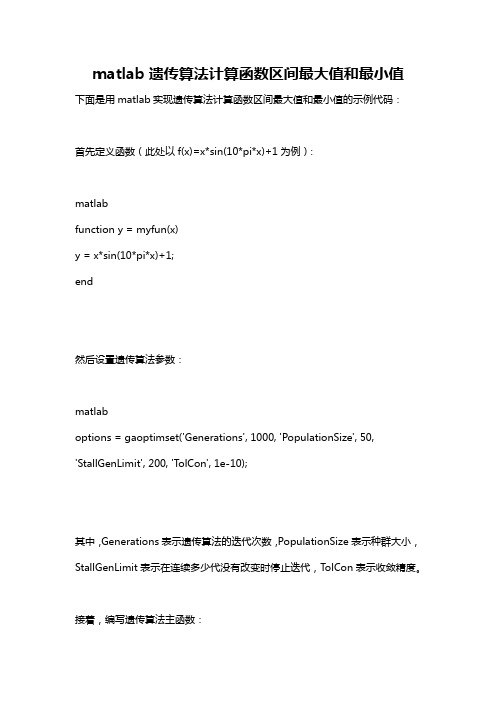
matlab遗传算法计算函数区间最大值和最小值下面是用matlab实现遗传算法计算函数区间最大值和最小值的示例代码:首先定义函数(此处以f(x)=x*sin(10*pi*x)+1为例):matlabfunction y = myfun(x)y = x*sin(10*pi*x)+1;end然后设置遗传算法参数:matlaboptions = gaoptimset('Generations', 1000, 'PopulationSize', 50,'StallGenLimit', 200, 'TolCon', 1e-10);其中,Generations表示遗传算法的迭代次数,PopulationSize表示种群大小,StallGenLimit表示在连续多少代没有改变时停止迭代,TolCon表示收敛精度。
接着,编写遗传算法主函数:matlab[x, fval] = ga(@myfun, 1, [], [], [], [], -1, 2, [], [], options);其中,第一个参数为要优化的函数,第二个参数为变量维度,后面的参数为变量的取值范围。
最后,输出结果:matlabfprintf('Function maximum is %f\n',-fval);fprintf('Function minimum is %f\n',fval);其中,-fval表示函数最大值,fval表示函数最小值。
完整代码如下:matlabfunction y = myfun(x)y = x*sin(10*pi*x)+1;endoptions = gaoptimset('Generations', 1000, 'PopulationSize', 50, 'StallGenLimit', 200, 'TolCon', 1e-10);[x, fval] = ga(@myfun, 1, [], [], [], [], -1, 2, [], [], options);fprintf('Function maximum is %f\n',-fval);fprintf('Function minimum is %f\n',fval);参考资料:[1][2]。
用遗传算法求函数的最大值MATLAB程序
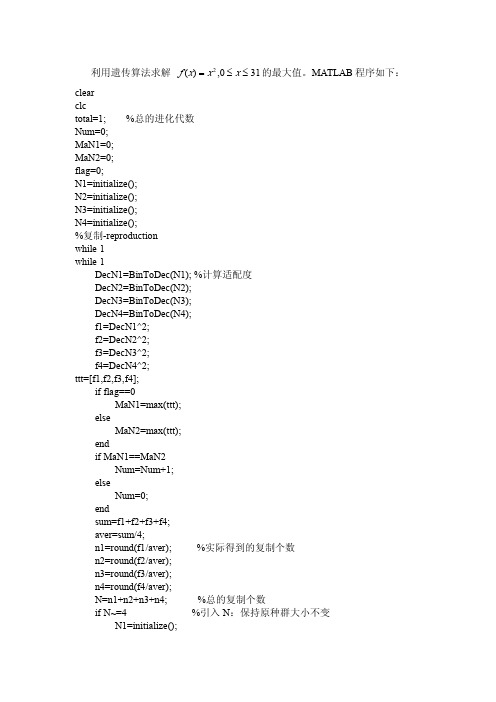
N2=initialize(); N3=initialize(); N4=initialize(); total=1; Num=0; MaN1=0; MaN2=0; flag=0; continue; else break; end end temp1=cal(N1,n1); temp2=cal(N2,n2); temp3=cal(N3,n3); temp4=cal(N4,n4); M=[temp1;temp2;temp3;temp4]; N1=M(1,:); N2=M(2,:); N3=M(3,:); N4=M(4,:); %交叉-crossover while 1 p=floor(1000*rand); if p>1 break; else continue; end end k=mod(p,3); switch k case 0 [N1,N2,N3,N4,ps]=crossover(N1,N2,N3,N4); case 1 [N1,N3,N2,N4,ps]=crossover(N1,N3,N2,N4); case 2 [N1,N4,N2,N3,ps]=crossover(N1,N4,N2,N3); end %变异-mutation U=[N1,N2,N3,N4]; pos=mod(floor(1000*rand),20)+1; if U(1 U(1,pos)=0; end N1=U(1,1:5); N2=U(1,6:10); N3=U(1,11:15); N4=U(1,16:20); %遗传算法结束条件:连续 10 代最大值均保持一致 if Num==10 disp('进化代数:') total-10 disp('现在的种群:') N1 N2 N3 N4 disp('最大值:') MaN1 break; end flag=mod(flag+1,2); total=total+1; end MATLAB 仿真结果:
遗传算法的MATLAB程序实例之欧阳歌谷创编
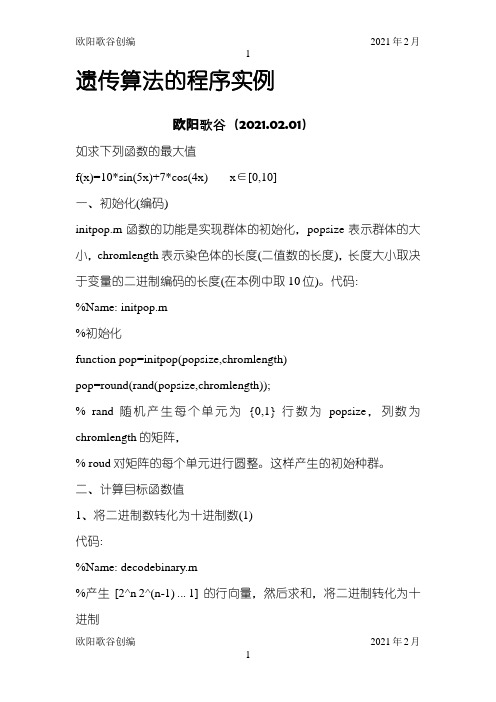
遗传算法的程序实例欧阳歌谷(2021.02.01)如求下列函数的最大值f(x)=10*sin(5x)+7*cos(4x) x∈[0,10]一、初始化(编码)initpop.m函数的功能是实现群体的初始化,popsize表示群体的大小,chromlength表示染色体的长度(二值数的长度),长度大小取决于变量的二进制编码的长度(在本例中取10位)。
代码:%Name: initpop.m%初始化function pop=initpop(popsize,chromlength)pop=round(rand(popsize,chromlength));% rand随机产生每个单元为{0,1} 行数为popsize,列数为chromlength的矩阵,% roud对矩阵的每个单元进行圆整。
这样产生的初始种群。
二、计算目标函数值1、将二进制数转化为十进制数(1)代码:%Name: decodebinary.m%产生[2^n 2^(n-1) ... 1] 的行向量,然后求和,将二进制转化为十进制function pop2=decodebinary(pop)[px,py]=size(pop); %求pop行和例数for i=1:pypop1(:,i)=2.^(py-1).*pop(:,i);py=py-1;endpop2=sum(pop1,2); %求pop1的每行之和2、将二进制编码转化为十进制数(2)decodechrom.m函数的功能是将染色体(或二进制编码)转换为十进制,参数spoint表示待解码的二进制串的起始位置。
(对于多个变量而言,如有两个变量,采用20为表示,每个变量10为,则第一个变量从1开始,另一个变量从11开始。
本例为1),参数1ength 表示所截取的长度(本例为10)。
代码:%Name: decodechrom.m%将二进制编码转换成十进制function pop2=decodechrom(pop,spoint,length)pop1=pop(:,spoint:spoint+length-1);pop2=decodebinary(pop1);3、计算目标函数值calobjvalue.m函数的功能是实现目标函数的计算,其公式采用本文示例仿真,可根据不同优化问题予以修改。
遗传算法用matlab求函数极大值

遗传算法用matlab求函数极大值一、题目:寻找f(x)=x2,,当x在0~31区间的最大值。
二、源程序:%遗传算法求解函数最大值%本程序用到了英国谢菲尔德大学(Sheffield)开发的工具箱GATBX,该工具箱比matlab自带的GATOOL使用更加灵活,但在编写程序方面稍微复杂一些Close all;Clear all;figure(1);fplot('variable*variable',[0,31]); %画出函数曲线%以下定义遗传算法参数GTSM=40; %定义个体数目ZDYCDS=20; %定义最大遗传代数EJZWS=5; %定义变量的二进制位数DG=0.9; %定义代沟trace=zeros(2, ZDYCDS); %最优结果的初始值FieldD=[5;-1;2;1;0;1;1]; %定义区域描述器的各个参数%以下为遗传算法基本操作部分,包括创建初始种群、复制、交叉和变异Chrom=crtbp(GTSM, EJZWS); %创建初始种群,即生成给定规模的二进制种群和结构gen=0; %定义代数计数器初始值variable=bs2rv(Chrom, FieldD); %对生成的初始种群进行十进制转换ObjV=variable*variable; %计算目标函数值f(x)=x2 while gen<ZDYCDS %进行循环控制,当当前代数小于定义的最大遗传代数时,继续循环,直至代数等于最大遗传代数FitnV=ranking(-ObjV); %分配适应度值SelCh=select('sus', Chrom, FitnV, DG); %选择,即对个体按照他们的适配值进行复制SelCh=recombin('xovsp', SelCh, 0.7); %交叉,即首先将复制产生的匹配池中的成员随机两两匹配,再进行交叉繁殖SelCh=mut(SelCh); %变异,以一个很小的概率随机地改变一个个体串位的值variable=bs2rv(SelCh, FieldD); %子代个体的十进制转换ObjVSel=variable*variable; %计算子代的目标函数值[Chrom ObjV]=reins(Chrom, SelCh, 1, 1, ObjV, ObjVSel);%再插入子代的新种群,其中Chrom为包含当前种群个体的矩阵,SelCh为包好当前种群后代的矩阵variable=bs2rv(Chrom, FieldD); %十进制转换gen=gen+1; %代数计数器增加%输出最优解及其序号,并在目标函数图像中标出,Y为最优解, I为种群的%序号[Y, I]=max(ObjV);hold on; %求出其最大目标函数值plot(variable(I), Y, 'bo');trace(1, gen)=max(ObjV); %遗传算法性能跟踪trace(2, gen)=sum(ObjV)/length(ObjV);end%以下为结果显示部分,通过上面计算出的数值进行绘图variable=bs2rv(Chrom, FieldD); %最优个体进行十进制转换hold on, grid;plot(variable,ObjV,'b*'); %将结果画出三、运行结果:由图可见该函数为单调递增函数,即当X=31时,该取得最大值f(x)max =961。
实验五:遗传算法求解函数最值问题实验

EJdoublefitness(constCh^crrcscrcRc)
{
doublek,y;
decode(cx# y);
retiurnf(x, y)+5;
2•交叉操作
首先是根据交叉概率probCross选择要交叉的个体进行交叉
//根据交叉槪率进行交叉
for(inti=pre = -1;i<N; i++)
//根据变异概率迸行变异
for (inti=0;i<N; i++)
if(randQm61() < probMutation)
mutate(group[i]);
变异时先随机生成变异的位置,然后把改位的01值翻转。
//变异操作
Hvoidmutate(ChrcfnosomeS c)
{
//随机选行翻转
inti-rand()%len; c-g[i] =
//骑越
boolflag-令;
for(inti = j=0; i<1.亡n;i++)
swap(d.g[l]Jc2.g[i]);
if(i== crosspcint[j])
//妇杲若干个交叉点重合”则效果叠加 "偃数个交叉点效果瑁当于没有交叉点while(j<
flag = [flag;
3.变异操作
首先是根据变异概率probMutation选择要变异的个体
经过一定的进化之后得到最终种群,从中选择最优的个体即可得
到最终的结果。
//获取种群最优你
-intgetOptimal(Ch^crescr:-oup[mxn]doubled—double&』doubled\)
遗传算法求函数极大值(matlab实现)
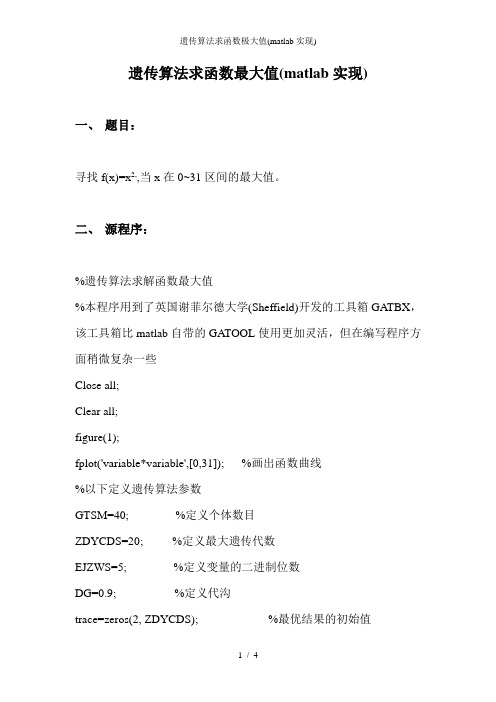
遗传算法求函数最大值(matlab实现)一、题目:寻找f(x)=x2,,当x在0~31区间的最大值。
二、源程序:%遗传算法求解函数最大值%本程序用到了英国谢菲尔德大学(Sheffield)开发的工具箱GATBX,该工具箱比matlab自带的GATOOL使用更加灵活,但在编写程序方面稍微复杂一些Close all;Clear all;figure(1);fplot('variable*variable',[0,31]); %画出函数曲线%以下定义遗传算法参数GTSM=40; %定义个体数目ZDYCDS=20; %定义最大遗传代数EJZWS=5; %定义变量的二进制位数DG=0.9; %定义代沟trace=zeros(2, ZDYCDS); %最优结果的初始值FieldD=[5;-1;2;1;0;1;1]; %定义区域描述器的各个参数%以下为遗传算法基本操作部分,包括创建初始种群、复制、交叉和变异Chrom=crtbp(GTSM, EJZWS); %创建初始种群,即生成给定规模的二进制种群和结构gen=0; %定义代数计数器初始值variable=bs2rv(Chrom, FieldD); %对生成的初始种群进行十进制转换ObjV=variable*variable; %计算目标函数值f(x)=x2 while gen<ZDYCDS %进行循环控制,当当前代数小于定义的最大遗传代数时,继续循环,直至代数等于最大遗传代数FitnV=ranking(-ObjV); %分配适应度值SelCh=select('sus', Chrom, FitnV, DG); %选择,即对个体按照他们的适配值进行复制SelCh=recombin('xovsp', SelCh, 0.7); %交叉,即首先将复制产生的匹配池中的成员随机两两匹配,再进行交叉繁殖SelCh=mut(SelCh); %变异,以一个很小的概率随机地改变一个个体串位的值variable=bs2rv(SelCh, FieldD); %子代个体的十进制转换ObjVSel=variable*variable; %计算子代的目标函数值[Chrom ObjV]=reins(Chrom, SelCh, 1, 1, ObjV, ObjVSel);%再插入子代的新种群,其中Chrom为包含当前种群个体的矩阵,SelCh为包好当前种群后代的矩阵variable=bs2rv(Chrom, FieldD); %十进制转换gen=gen+1; %代数计数器增加%输出最优解及其序号,并在目标函数图像中标出,Y为最优解,I 为种群的%序号[Y, I]=max(ObjV);hold on; %求出其最大目标函数值plot(variable(I), Y, 'bo');trace(1, gen)=max(ObjV); %遗传算法性能跟踪trace(2, gen)=sum(ObjV)/length(ObjV);end%以下为结果显示部分,通过上面计算出的数值进行绘图variable=bs2rv(Chrom, FieldD); %最优个体进行十进制转换hold on, grid;plot(variable,ObjV,'b*'); %将结果画出三、运行结果:由图可见该函数为单调递增函数,即当X=31时,该取得最大值f(x)max=961。
(完整版)遗传算法求解函数最大值(matlab)
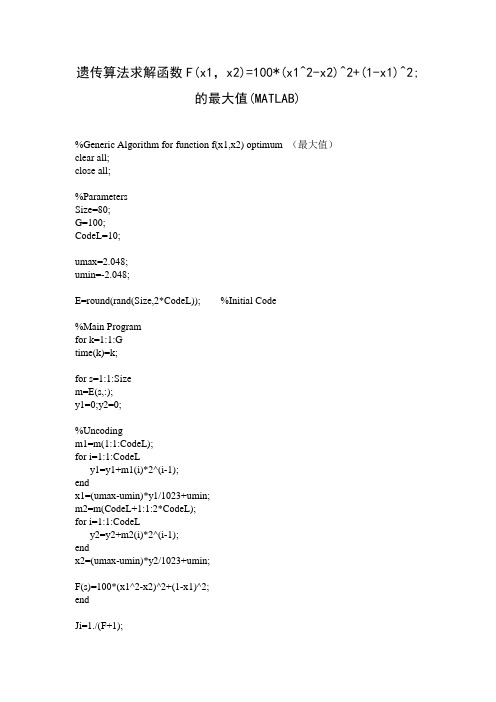
遗传算法求解函数F(x1,x2)=100*(x1^2-x2)^2+(1-x1)^2;的最大值(MATLAB)%Generic Algorithm for function f(x1,x2) optimum (最大值)clear all;close all;%ParametersSize=80;G=100;CodeL=10;umax=2.048;umin=-2.048;E=round(rand(Size,2*CodeL)); %Initial Code%Main Programfor k=1:1:Gtime(k)=k;for s=1:1:Sizem=E(s,:);y1=0;y2=0;%Uncodingm1=m(1:1:CodeL);for i=1:1:CodeLy1=y1+m1(i)*2^(i-1);endx1=(umax-umin)*y1/1023+umin;m2=m(CodeL+1:1:2*CodeL);for i=1:1:CodeLy2=y2+m2(i)*2^(i-1);endx2=(umax-umin)*y2/1023+umin;F(s)=100*(x1^2-x2)^2+(1-x1)^2;endJi=1./(F+1);%****** Step 1 : Evaluate BestJ ******BestJ(k)=min(Ji);fi=F; %Fitness Function[Oderfi,Indexfi]=sort(fi); %Arranging fi small to biggerBestfi=Oderfi(Size); %Let Bestfi=max(fi)BestS=E(Indexfi(Size),:); %Let BestS=E(m), m is the Indexfi belong to max(fi)bfi(k)=Bestfi;%****** Step 2 : Select and Reproduct Operation******fi_sum=sum(fi);fi_Size=(Oderfi/fi_sum)*Size;fi_S=floor(fi_Size); %Selecting Bigger fi value (取整)kk=1;for i=1:1:Sizefor j=1:1:fi_S(i) %Select and ReproduceTempE(kk,:)=E(Indexfi(i),:);kk=kk+1; %kk is used to reproduceendend%************ Step 3 : Crossover Operation ************pc=0.60;n=ceil(20*rand);for i=1:2:(Size-1)temp=rand;if pc>temp %Crossover Conditionfor j=n:1:20TempE(i,j)=E(i+1,j);TempE(i+1,j)=E(i,j);endendendTempE(Size,:)=BestS;E=TempE;%************ Step 4: Mutation Operation **************%pm=0.001;%pm=0.001-[1:1:Size]*(0.001)/Size; %Bigger fi, smaller Pm%pm=0.0; %No mutationpm=0.1; %Big mutationfor i=1:1:Sizefor j=1:1:2*CodeLtemp=rand;if pm>temp %Mutation Conditionif TempE(i,j)==0TempE(i,j)=1;elseTempE(i,j)=0;endendendend%Guarantee TempPop(30,:) is the code belong to the best individual(max(fi)) TempE(Size,:)=BestS;E=TempE;endMax_Value=BestfiBestSx1x2figure(1);plot(time,BestJ);xlabel('Times');ylabel('Best J');figure(2);plot(time,bfi);xlabel('times');ylabel('Best F');轐行绒果Map_Falue =3.9059e+ 03BestS =0 0 0 0 0 0 0 0 0 0 0 0 0 0 0 0 0 0 Р0ɸ1 =-2&0480x2 =-2.0080。
遗传算法matlab代码
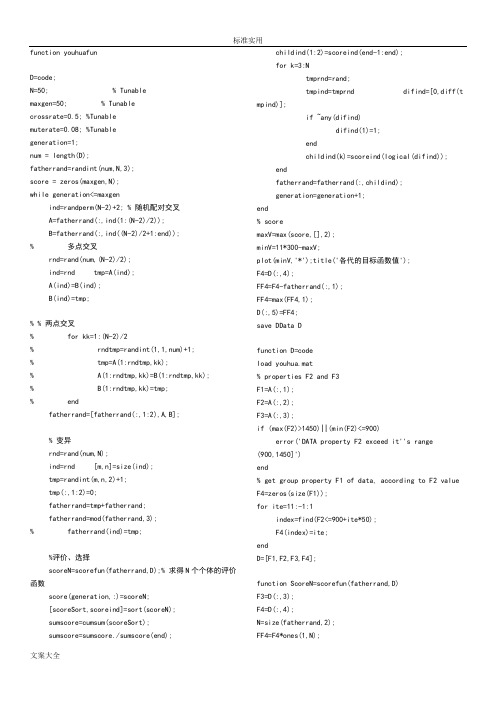
function youhuafunD=code;N=50; % Tunablemaxgen=50; % Tunablecrossrate=0.5; %Tunablemuterate=0.08; %Tunablegeneration=1;num = length(D);fatherrand=randint(num,N,3);score = zeros(maxgen,N);while generation<=maxgenind=randperm(N-2)+2; % 随机配对交叉A=fatherrand(:,ind(1:(N-2)/2));B=fatherrand(:,ind((N-2)/2+1:end));% 多点交叉rnd=rand(num,(N-2)/2);ind=rnd tmp=A(ind);A(ind)=B(ind);B(ind)=tmp;% % 两点交叉% for kk=1:(N-2)/2% rndtmp=randint(1,1,num)+1;% tmp=A(1:rndtmp,kk);% A(1:rndtmp,kk)=B(1:rndtmp,kk);% B(1:rndtmp,kk)=tmp;% endfatherrand=[fatherrand(:,1:2),A,B];% 变异rnd=rand(num,N);ind=rnd [m,n]=size(ind);tmp=randint(m,n,2)+1;tmp(:,1:2)=0;fatherrand=tmp+fatherrand;fatherrand=mod(fatherrand,3);% fatherrand(ind)=tmp;%评价、选择scoreN=scorefun(fatherrand,D);% 求得N个个体的评价函数score(generation,:)=scoreN;[scoreSort,scoreind]=sort(scoreN);sumscore=cumsum(scoreSort);sumscore=sumscore./sumscore(end);childind(1:2)=scoreind(end-1:end);for k=3:Ntmprnd=rand;tmpind=tmprnd difind=[0,diff(t mpind)];if ~any(difind)difind(1)=1;endchildind(k)=scoreind(logical(difind));endfatherrand=fatherrand(:,childind);generation=generation+1;end% scoremaxV=max(score,[],2);minV=11*300-maxV;plot(minV,'*');title('各代的目标函数值');F4=D(:,4);FF4=F4-fatherrand(:,1);FF4=max(FF4,1);D(:,5)=FF4;save DData Dfunction D=codeload youhua.mat% properties F2 and F3F1=A(:,1);F2=A(:,2);F3=A(:,3);if (max(F2)>1450)||(min(F2)<=900)error('DATA property F2 exceed it''s range(900,1450]')end% get group property F1 of data, according to F2 value F4=zeros(size(F1));for ite=11:-1:1index=find(F2<=900+ite*50);F4(index)=ite;endD=[F1,F2,F3,F4];function ScoreN=scorefun(fatherrand,D)F3=D(:,3);F4=D(:,4);N=size(fatherrand,2);FF4=F4*ones(1,N);FF4rnd=FF4-fatherrand;FF4rnd=max(FF4rnd,1);ScoreN=ones(1,N)*300*11;% 这里有待优化for k=1:NFF4k=FF4rnd(:,k);for ite=1:11F0index=find(FF4k==ite);if ~isempty(F0index)tmpMat=F3(F0index);tmpSco=sum(tmpMat);ScoreBin(ite)=mod(tmpSco,300);endendScorek(k)=sum(ScoreBin);endScoreN=ScoreN-Scorek;遗传算法实例:% 下面举例说明遗传算法 %% 求下列函数的最大值 %% f(x)=10*sin(5x)+7*cos(4x) x∈[0,10] %% 将 x 的值用一个10位的二值形式表示为二值问题,一个10位的二值数提供的分辨率是每为 (10-0)/(2^10-1)≈0.01 。
基于Matlab用遗传算法求一元函数最值问题(附源码)

基于Matlab⽤遗传算法求⼀元函数最值问题(附源码)问题:求y=10cos(5x x)+7sin(x-5)+10x x的最⼩值要求:(1)⽤遗传算法编程求解问题(2)编程语⾔⽤MATLAB 或C(3)输出问题的最优解及最⼤值,并绘图显⽰⽅法⼀function.mclear all;close all;clc;x=-1:0.01:0;y=10.*cos(5.*x.*x)+7.*sin(x-5.0)+10.*x.*x;figureplot(x,y)grid onxlabel('x')ylabel('f(x)')title('f(x)=10*cos(5*x*x)+7*sin(x-5)+10*x*x')%%f(x)=10*cos(5*x*x)+7*sin(x-5)+10*x*x1)运⾏结果函数取(-1,0)定义域,能够显⽰出的X=-0.7733时,Y=-0.4888,图像如下⽅法⼆func.mclear all;close all;clc;x=-1:0.01:0;y=10.*cos(5.*x.*x)+7.*sin(x-5.0)+10.*x.*x;figureplot(x,y)grid onxlabel('x')ylabel('f(x)')title('f(x)=10*cos(5*x*x)+7*sin(x-5)+10*x*x')%%f(x)=10*cos(5*x*x)+7*sin(x-5)+10*x*xmain.mclear all; %清除所有变量close all; %清图clc; %清屏nvars = 1;LB = -1;UB = 0;[t,fval] =ga(@test,1,[],[],[],[],LB,UB)fplot(@(x)(10.*cos(5.*x.*x)+7.*sin(x-5)+10.*x.*x),[-1 0]);hold on;plot(t,fval,'*');function y = test(x)y = 10*cos(5*x*x)+7*sin(x-5)+10*x*xendsimple_fitness.m%⽬标函数x = -1:0.01:0;%y=10*cos(5*x*x)+7*sin(x-5)+10*x*x;y=10.*cos(5.*x.*x)+7.*sin(x-5)+10.*x.*x;plot(x,y);%%%%%%%%%%%%%%%初始化参数%%%%%%%%%%%%%%%clear all; %清除所有变量close all; %清图clc; %清屏NP=50; %种群规模(数量)L = 20; %⼆进制位串长度Pc = 0.8; %交叉率Pm = 0.1; %变异率G = 100; %最⼤遗传代数Xs = 1; %上限Xx = -0; %下限f = randi([0,1],NP,L);%随机获得初始种群xB =[];%%%%%%%%%%%%%%%遗传算法循环%%%%%%%%%%%%%%%for k = 1:G%%%%%%%%%%%%%%%将⼆进制解码为定义域范围内⼗进制%%%%%%%%%%%%%%%for i = 1:NPU = f(i,:);m = 0;for j = 1:Lm = U(j)*2^(j-1)+m;endx(i) = Xx+m*(Xs-Xx)/(2^L-1);Fit(i) = 1/func1(x(i));endmaxFit = max(Fit);minFit = min(Fit);rr = find(Fit==maxFit);fBest = f(rr(1,1),:);xBest = x(rr(1,1));xB(i)=xBest;Fit = (Fit-minFit)/(maxFit-minFit);%%%%%%%%%%%%%%%基于轮盘赌的复制操作%%%%%%%%%%%%%%% sum_Fit = sum(Fit);fitvalue = Fit./sum_Fit;fitvalue = cumsum(fitvalue);ms = sort(rand(NP,1));fiti = 1;newi = 1;while newi <= NPif (ms(newi)) < fitvalue(fiti)nf(newi,:) = f(fiti,:);newi = newi + 1;elsefiti = fiti+1;endend%%%%%%%%%%%%%%%基于概率的交叉操作%%%%%%%%%%%%%%% for i=1:2:NPp = rand;if p < Pcq = randi(1,1,L);for j = 1:Lif q(j)==1;temp = nf(i+1,j);nf(i+1,j) = nf(i,j);nf(i,j) = temp;endendendend%%%%%%%%%%%%%%%基于概率的变异操作%%%%%%%%%%%%%%% i= 1;while i<= round(NP*Pm)h = randi([1,NP]);for j = 1:round(L*Pm)g = randi([1,L]);nf(h,g) =~ nf(h,g);endi=i+1;endf=nf;f(1,:) = fBest;trace(k) = maxFit;endxBest;fBestt=func1(xBest);subplot(1,2,1)plot(trace)xlabel('迭代次数')ylabel('⽬标函数值')title('适应度进化曲线')subplot(1,2,2)fplot(@(x)(10.*cos(5.*x.*x)+7.*sin(x-5)+10.*x.*x),[-1 0]);hold on;plot(xBest,func1(xBest),'*');%%%%%%%%%%%%%%%适应度函数%%%%%%%%%%%%%%%function result = func1(x)%fit = x+10*sin(5*x)+7*cos(4*x);fit = 10.*cos(5.*x.*x)+7.*sin(x-5)+10.*x.*x;result = fit;end1)运⾏结果适应度曲线函数图像。
遗传算法的MATLAB求解 实例

求解一元函数f(x)=x*sin(10π*x)+2.0,x∈[-1,2]M文件,执行遗传算法求解单目标函数的最优值fplot('varible.*sin(10*pi*varible)+2.0',[-1,2]); %画出函数曲线NIND=40; %定义个体数目MAXGEN=25; %定义最大遗传代数PRECI=20; %变量的二进制位数GGAP=0.9; %代沟trace=zeros(2,MAXGEN);%寻优结果的初始值FieldD=[20;-1;2;1;0;1;1]; %区域描述器Chrom=crtbp(NIND,PRECI); %初始群体gen=0; %代计数器varible=bs2rv(Chrom,FieldD); %计算初试群体的十进制转换ObjV=varible.*sin(10*pi*varible)+2.0;%计算目标函数值while gen < MAXGENFitnV=ranking(-ObjV); %分配适应度值SelCh=select('sus',Chrom,FitnV,GGAP); %选择SelCh=recombin('xovsp',SelCh,0.7); %重组SelCh=mut(SelCh); %变异varible=bs2rv(SelCh,FieldD); %子代个体的十进制转换ObjVSel=varible.*sin(10*pi*varible)+2.0; %计算子代的目标函数值[Chrom,ObjV]=reins(Chrom,SelCh,1,1,ObjV,ObjVSel);%重插入子代为新的种群%输出最优解及其序号,并在目标函数图像中标出,Y为最优解,I为种群序号gen=gen+1;[Y,I]=max(ObjV),hold on; %输出最优值trace(1,gen)=max(ObjV); %最优解trace(2,gen)=sum(ObjV)/length(ObjV); %解均值endvarible=bs2rv(Chrom,FieldD); %最优个体的十进制转换hold on,grid;plot(varible',ObjV','b*'); %画出种群及值重新调用MATLAB命令,执行以下命令plot(trace(1,:)');hold on;plot(trace(2,:)','-.');grid;legend('解的变化','种群均值的变化')。
遗传算法matlab

% 下面举例说明遗传算法%% 求下列函数的最大值%% f(x)=10*sin(5x)+7*cos(4x) x∈[0,10] %% 将x 的值用一个10位的二值形式表示为二值问题,一个10位的二值数提供的分辨率是每为(10-0)/(2^10-1)≈0.01 。
%% 将变量域[0,10] 离散化为二值域[0,1023], x=0+10*b/1023, 其中b 是[0,1023] 中的一个二值数。
%% %%--------------------------------------------------------------------------------------------------------------%%--------------------------------------------------------------------------------------------------------------%% 编程%-----------------------------------------------% 2.1初始化(编码)% initpop.m函数的功能是实现群体的初始化,popsize表示群体的大小,chromlength表示染色体的长度(二值数的长度),% 长度大小取决于变量的二进制编码的长度(在本例中取10位)。
%遗传算法子程序%Name: initpop.m%初始化function pop=initpop(popsize,chromlength)pop=round(rand(popsize,chromlength)); % rand随机产生每个单元为{0,1} 行数为popsize,列数为chromlength的矩阵,% roud对矩阵的每个单元进行圆整。
这样产生的初始种群。
% 2.2 计算目标函数值% 2.2.1 将二进制数转化为十进制数(1)%遗传算法子程序%Name: decodebinary.m%产生[2^n 2^(n-1) ... 1] 的行向量,然后求和,将二进制转化为十进制function pop2=decodebinary(pop)[px,py]=size(pop); %求pop行和列数for i=1:pypop1(:,i)=2.^(py-i).*pop(:,i);endpop2=sum(pop1,2); %求pop1的每行之和% 2.2.2 将二进制编码转化为十进制数(2)% decodechrom.m函数的功能是将染色体(或二进制编码)转换为十进制,参数spoint表示待解码的二进制串的起始位置% (对于多个变量而言,如有两个变量,采用20为表示,每个变量10为,则第一个变量从1开始,另一个变量从11开始。
遗传算法matlab代码

function youhuafunD=code;N=50; % Tunablemaxgen=50; % Tunablecrossrate=0.5; %Tunablemuterate=0.08; %Tunablegeneration=1;num = length(D);fatherrand=randint(num,N,3);score = zeros(maxgen,N);while generation<=maxgenind=randperm(N-2)+2; % 随机配对交叉A=fatherrand(:,ind(1:(N-2)/2));B=fatherrand(:,ind((N-2)/2+1:end));% 多点交叉rnd=rand(num,(N-2)/2);ind=rnd tmp=A(ind);A(ind)=B(ind);B(ind)=tmp;% % 两点交叉% for kk=1:(N-2)/2% rndtmp=randint(1,1,num)+1; % tmp=A(1:rndtmp,kk);% A(1:rndtmp,kk)=B(1:rndtmp,kk);% B(1:rndtmp,kk)=tmp;% endfatherrand=[fatherrand(:,1:2),A,B];% 变异rnd=rand(num,N);ind=rnd [m,n]=size(ind);tmp=randint(m,n,2)+1;tmp(:,1:2)=0;fatherrand=tmp+fatherrand;fatherrand=mod(fatherrand,3);% fatherrand(ind)=tmp;%评价、选择scoreN=scorefun(fatherrand,D);% 求得N个个体的评价函数score(generation,:)=scoreN;[scoreSort,scoreind]=sort(scoreN);sumscore=cumsum(scoreSort);sumscore=sumscore./sumscore(end);childind(1:2)=scoreind(end-1:end);for k=3:Ntmprnd=rand;tmpind=tmprnd difind=[0,diff(tmpind)];if ~any(difind)difind(1)=1;endchildind(k)=scoreind(logical(difind));endfatherrand=fatherrand(:,childind); generation=generation+1;end% scoremaxV=max(score,[],2);minV=11*300-maxV;plot(minV,'*');title('各代的目标函数值');F4=D(:,4);FF4=F4-fatherrand(:,1);FF4=max(FF4,1);D(:,5)=FF4;save DData Dfunction D=codeload youhua.mat% properties F2 and F3F1=A(:,1); F2=A(:,2);F3=A(:,3);if (max(F2)>1450)||(min(F2)<=900)error('DATA property F2 exceed it''s range (900,1450]') end% get group property F1 of data, according to F2 value F4=zeros(size(F1));for ite=11:-1:1index=find(F2<=900+ite*50);F4(index)=ite;endD=[F1,F2,F3,F4];function ScoreN=scorefun(fatherrand,D)F3=D(:,3);F4=D(:,4);N=size(fatherrand,2);FF4=F4*ones(1,N);FF4rnd=FF4-fatherrand;FF4rnd=max(FF4rnd,1);ScoreN=ones(1,N)*300*11;% 这里有待优化for k=1:NFF4k=FF4rnd(:,k);for ite=1:11F0index=find(FF4k==ite);if ~isempty(F0index)tmpMat=F3(F0index);tmpSco=sum(tmpMat);ScoreBin(ite)=mod(tmpSco,300);endendScorek(k)=sum(ScoreBin);endScoreN=ScoreN-Scorek;遗传算法实例:% 下面举例说明遗传算法%% 求下列函数的最大值%% f(x)=10*sin(5x)+7*cos(4x) x∈[0,10] %% 将x 的值用一个10位的二值形式表示为二值问题,一个10位的二值数提供的分辨率是每为(10-0)/(2^10-1)≈0.01 。
matlab遗传算法实例
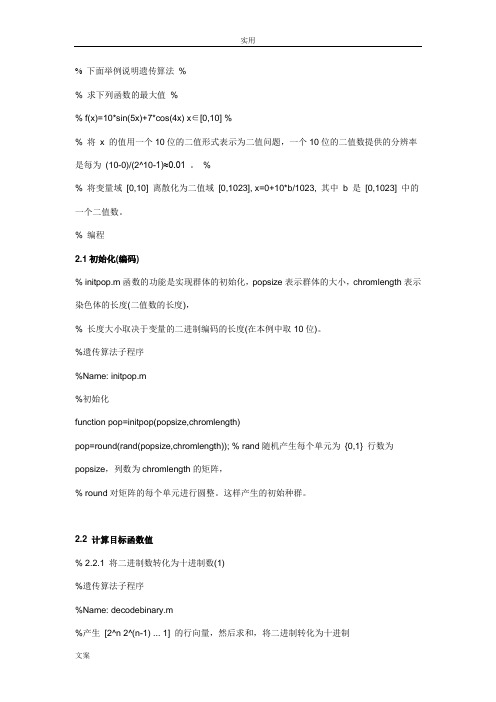
% 下面举例说明遗传算法%% 求下列函数的最大值%% f(x)=10*sin(5x)+7*cos(4x) x∈[0,10] %% 将x 的值用一个10位的二值形式表示为二值问题,一个10位的二值数提供的分辨率是每为(10-0)/(2^10-1)≈0.01 。
%% 将变量域[0,10] 离散化为二值域[0,1023], x=0+10*b/1023, 其中b 是[0,1023] 中的一个二值数。
% 编程2.1初始化(编码)% initpop.m函数的功能是实现群体的初始化,popsize表示群体的大小,chromlength表示染色体的长度(二值数的长度),% 长度大小取决于变量的二进制编码的长度(在本例中取10位)。
%遗传算法子程序%Name: initpop.m%初始化function pop=initpop(popsize,chromlength)pop=round(rand(popsize,chromlength)); % rand随机产生每个单元为{0,1} 行数为popsize,列数为chromlength的矩阵,% round对矩阵的每个单元进行圆整。
这样产生的初始种群。
2.2 计算目标函数值% 2.2.1 将二进制数转化为十进制数(1)%遗传算法子程序%Name: decodebinary.m%产生[2^n 2^(n-1) ... 1] 的行向量,然后求和,将二进制转化为十进制function pop2=decodebinary(pop)[px,py]=size(pop); %求pop行和列数for i=1:pypop1(:,i)=2.^(py-i).*pop(:,i);endpop2=sum(pop1,2); %求pop1的每行之和1表示每列相加,2表示每行相加% 2.2.2 将二进制编码转化为十进制数(2)% decodechrom.m函数的功能是将染色体(或二进制编码)转换为十进制,参数spoint表示待解码的二进制串的起始位置% (对于多个变量而言,如有两个变量,采用20为表示,每个变量10为,则第一个变量从1开始,另一个变量从11开始。
2021年遗传算法的MATLAB程序实例

遗传算法的程序实例欧阳光明(2021.03.07)如求下列函数的最大值f(x)=10*sin(5x)+7*cos(4x) x∈[0,10]一、初始化(编码)initpop.m函数的功能是实现群体的初始化,popsize表示群体的大小,chromlength表示染色体的长度(二值数的长度),长度大小取决于变量的二进制编码的长度(在本例中取10位)。
代码:%Name: initpop.m%初始化function pop=initpop(popsize,chromlength)pop=round(rand(popsize,chromlength));% rand随机产生每个单元为{0,1} 行数为popsize,列数为chromlength的矩阵,% roud对矩阵的每个单元进行圆整。
这样产生的初始种群。
二、计算目标函数值1、将二进制数转化为十进制数(1)代码:%Name: decodebinary.m%产生[2^n 2^(n-1) ... 1] 的行向量,然后求和,将二进制转化为十进制function pop2=decodebinary(pop)[px,py]=size(pop); %求pop行和例数for i=1:pypop1(:,i)=2.^(py-1).*pop(:,i);py=py-1;endpop2=sum(pop1,2); %求pop1的每行之和2、将二进制编码转化为十进制数(2)decodechrom.m函数的功能是将染色体(或二进制编码)转换为十进制,参数spoint表示待解码的二进制串的起始位置。
(对于多个变量而言,如有两个变量,采用20为表示,每个变量10为,则第一个变量从1开始,另一个变量从11开始。
本例为1),参数1ength表示所截取的长度(本例为10)。
代码:%Name: decodechrom.m%将二进制编码转换成十进制function pop2=decodechrom(pop,spoint,length)pop1=pop(:,spoint:spoint+length-1);pop2=decodebinary(pop1);3、计算目标函数值calobjvalue.m函数的功能是实现目标函数的计算,其公式采用本文示例仿真,可根据不同优化问题予以修改。
[精品]遗传算法求f(x)=x10sin(5x)7cos(4x)的最大值
![[精品]遗传算法求f(x)=x10sin(5x)7cos(4x)的最大值](https://img.taocdn.com/s3/m/6712e2074531b90d6c85ec3a87c24028915f854e.png)
【问题】求f(x)=x+10*sin(5x)+7*cos(4x)的最大值,其中0<=x<=9【分析】选择二进制编码,种群中的个体数目为10,二进制编码长度为20,交叉概率为0.95,变异概率为0.08【程序清单】%编写目标函数function[sol,eval]=fitness(sol,options)x=sol(1);eval=x+10*sin(5*x)+7*cos(4*x);%把上述函数存储为fitness.m文件并放在工作目录下initPop=initializega(10,[0 9],'fitness');%生成初始种群,大小为10[x endPop,bPop,trace]=ga([0 9],'fitness',[],initPop,[1e-6 1 1],'maxGenTerm',25,'normGeomSelect',...[0.08],['arithXover'],[2],'nonUnifMutation',[2 25 3]) %25次遗传迭代运算借过为:x =7.8562 24.8553(当x为7.8562时,f(x)取最大值24.8553)注:遗传算法一般用来取得近似最优解,而不是最优解。
遗传算法实例2【问题】在-5<=Xi<=5,i=1,2区间内,求解f(x1,x2)=-20*exp(-0.2*sqrt(0.5*(x1.^2+x2.^2)))-exp(0.5*(cos(2*pi*x1)+cos(2*pi*x2)))+22.7128 2的最小值。
【分析】种群大小10,最大代数1000,变异率0.1,交叉率0.3【程序清单】%源函数的matlab代码function [eval]=f(sol)numv=size(sol,2);x=sol(1:numv);eval=-20*exp(-0.2*sqrt(sum(x.^2)/numv)))-exp(sum(cos(2*pi*x))/numv)+22.71282;%适应度函数的matlab代码function [sol,eval]=fitness(sol,options)numv=size(sol,2)-1;x=sol(1:numv);eval=f(x);eval=-eval;%遗传算法的matlab代码bounds=ones(2,1)*[-5 5];[p,endPop,bestSols,trace]=ga(bounds,'fitness')注:前两个文件存储为m文件并放在工作目录下,运行结果为p =0.0000 -0.0000 0.0055大家可以直接绘出f(x)的图形来大概看看f(x)的最值是多少,也可是使用优化函数来验证。
遗传算法经典MATLAB代码
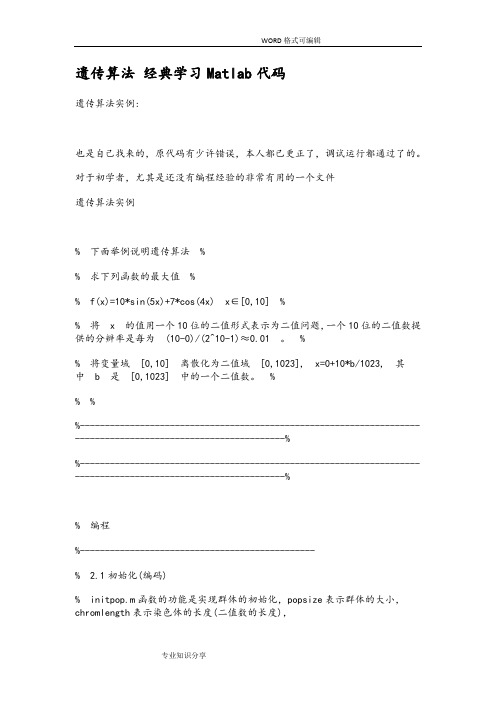
遗传算法经典学习Matlab代码遗传算法实例:也是自己找来的,原代码有少许错误,本人都已更正了,调试运行都通过了的。
对于初学者,尤其是还没有编程经验的非常有用的一个文件遗传算法实例% 下面举例说明遗传算法%% 求下列函数的最大值%% f(x)=10*sin(5x)+7*cos(4x) x∈[0,10]%% 将x 的值用一个10位的二值形式表示为二值问题,一个10位的二值数提供的分辨率是每为(10-0)/(2^10-1)≈0.01。
%% 将变量域[0,10] 离散化为二值域[0,1023], x=0+10*b/1023, 其中 b 是[0,1023] 中的一个二值数。
%% %%--------------------------------------------------------------------------------------------------------------%%--------------------------------------------------------------------------------------------------------------%% 编程%-----------------------------------------------% 2.1初始化(编码)% initpop.m函数的功能是实现群体的初始化,popsize表示群体的大小,chromlength表示染色体的长度(二值数的长度),% 长度大小取决于变量的二进制编码的长度(在本例中取10位)。
%遗传算法子程序%Name: initpop.m%初始化function pop=initpop(popsize,chromlength)pop=round(rand(popsize,chromlength)); % rand随机产生每个单元为{0,1} 行数为popsize,列数为chromlength的矩阵,% roud对矩阵的每个单元进行圆整。
遗传算法求方程最大值

/*
遗传算法应用举例————函数最大值问题的求解:f(x)=x*x(0<=x<=31)
课程名称:人工智能
专业:计算机软件理论
*/
class Chromosome //染色体类的定义
{
int geneString[]=new int[5];//基因位串
int fitness=0;//适应度
double chooseProbability=0.0;//选择概率
{
C1.fitness=fValue(C1.geneString)*fValue(C1.geneString);
C2.fitness=fValue(C2.geneString)*fValue(C2.geneString);
C3.fitness=fValue(C3.geneString)*fValue(C3.geneString);
Copy(C4,C2);
}
if(C3.chooseNumber==0)
{
System.out.println("C3要被淘汰");
if(C2.chooseNumber>1)
Copy(C2,C3);
if(C1.chooseNumber>1)
Copy(C1,C3);
if(C4.chooseNumber>1)
System.out.println(change(C1.geneString)+" "+fValue(C1.geneString)+" "+C1.fitness+" "+C1.chooseProbability+"
遗传算法求f(x)=x+10sin(5x)+7cos(4x)的最大值
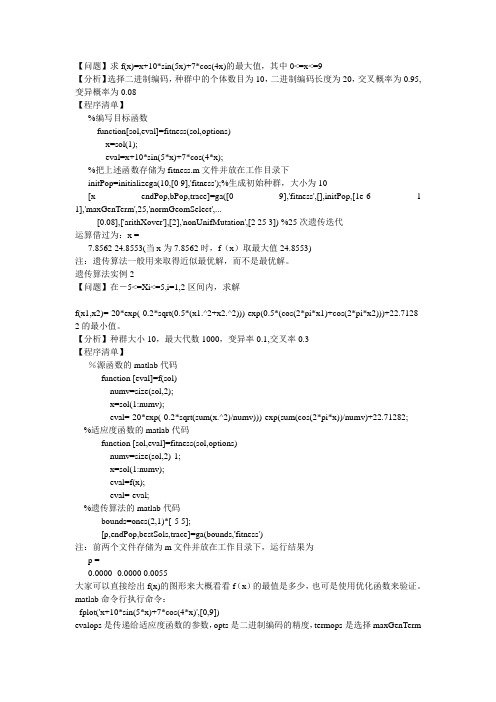
【问题】求f(x)=x+10*sin(5x)+7*cos(4x)的最大值,其中0<=x<=9【分析】选择二进制编码,种群中的个体数目为10,二进制编码长度为20,交叉概率为0.95,变异概率为0.08【程序清单】%编写目标函数function[sol,eval]=fitness(sol,options)x=sol(1);eval=x+10*sin(5*x)+7*cos(4*x);%把上述函数存储为fitness.m文件并放在工作目录下initPop=initializega(10,[0 9],'fitness');%生成初始种群,大小为10[x endPop,bPop,trace]=ga([0 9],'fitness',[],initPop,[1e-6 1 1],'maxGenTerm',25,'normGeomSelect',...[0.08],['arithXover'],[2],'nonUnifMutation',[2 25 3]) %25次遗传迭代运算借过为:x =7.8562 24.8553(当x为7.8562时,f(x)取最大值24.8553)注:遗传算法一般用来取得近似最优解,而不是最优解。
遗传算法实例2【问题】在-5<=Xi<=5,i=1,2区间内,求解f(x1,x2)=-20*exp(-0.2*sqrt(0.5*(x1.^2+x2.^2)))-exp(0.5*(cos(2*pi*x1)+cos(2*pi*x2)))+22.7128 2的最小值。
【分析】种群大小10,最大代数1000,变异率0.1,交叉率0.3【程序清单】%源函数的matlab代码function [eval]=f(sol)numv=size(sol,2);x=sol(1:numv);eval=-20*exp(-0.2*sqrt(sum(x.^2)/numv)))-exp(sum(cos(2*pi*x))/numv)+22.71282;%适应度函数的matlab代码function [sol,eval]=fitness(sol,options)numv=size(sol,2)-1;x=sol(1:numv);eval=f(x);eval=-eval;%遗传算法的matlab代码bounds=ones(2,1)*[-5 5];[p,endPop,bestSols,trace]=ga(bounds,'fitness')注:前两个文件存储为m文件并放在工作目录下,运行结果为p =0.0000 -0.0000 0.0055大家可以直接绘出f(x)的图形来大概看看f(x)的最值是多少,也可是使用优化函数来验证。
- 1、下载文档前请自行甄别文档内容的完整性,平台不提供额外的编辑、内容补充、找答案等附加服务。
- 2、"仅部分预览"的文档,不可在线预览部分如存在完整性等问题,可反馈申请退款(可完整预览的文档不适用该条件!)。
- 3、如文档侵犯您的权益,请联系客服反馈,我们会尽快为您处理(人工客服工作时间:9:00-18:30)。
hand2=plot(1:Generation,ymean);
set(hand2,'color','r','linestyle','-','linewidth',1.8,'marker','h','markersize',6)
function seln=selection(population,cumsump);
%从种群中选择两个个体
for i=1:2
r=rand; %产生一个随机数
prand=cumsump-r;
function pcc=IfCroIfMut(mutORcro);
test(1:100)=0;
l=round(100*mutORcro);
test(1:1)=1;
n=round(rand*99)+1;
pcc=test(n);
%子程序:新种群选择操作,函数名称存储为selection.m
本文件的目的是减少您打字的烦恼
%主程序:用遗传算法求解y=200*exp(-0.05*x).*sin(x)在[-2 2]区间上的最大值
clc;
clear all;
close all;
for j=1:2:popsize
%选择操作
seln=selection(population,cumsump);
%交叉操作
scro=crossover(population,seln,pcrossover);
scnew(j,:)=scro(1,:);
scnew(j+1,:)=scro(2,:);
boundsbegin=bounds(:,1);
boundsend=bounds(:,2);
%计算如果满足求解精度至少需要多长的染色体
BitLength=ceil(log2((boundsend-boundsbegin)'./precision));
popsize=50; %初始种群大小
Fitvalue(i)=tar
%给适应度函数加上一个大小合理的数以便保证种群适应值为正数
Fitvalue=Fitvalue'+230;
%计算选择概率
scro(2,:)=[population(seln(2),1:chb) population(seln(1),chb+1:BitLength)];
else
scro(1,:)=population(seln(1),:);
scro(2,:)=population(seln(2),:);
end
%趋同的形态,表示算法收敛进行的很顺利,没有出现震荡;在这种前提下,最大适应度个体连续若干代都没有发生进化表明种群已经成熟
%作图
figure(1);
hand1=plot(1:Generation,ymax);
set(hand1,'linestyle','-','linewidth',1.8,'marker','*','markersize',6)
population=round(rand(popsize,BitLength));
%计算适应度,返回适应度Fitvalue和累积概率cumsump
[Fitvalue,cumsump]=fitnessfun(population);
Generation=1;
while Generation<Generationnmax+1
for i=1:popsize
x=transform2to10(population(i,:)); %将二进制转化为十进制
%转化为[-2 2]区间的实数
xx=boundsbegin+x*(boundsend-boundsbegin)/(power((boundsend),BitLength)-1);
fsum=sum(Fitvalue);
Pperpopulation=Fitvalue/fsum;
%计算累积概率
cumsump(1)=Pperpopulation(1);
for i=2:popsize
cumsump(i)=cumsump(i-1)+Pperpopulation(i);
end
function scro=crossover(population,seln,pc);
BitLength=si
ze(population,2);
pcc=IfCroIfMut(pc); %根据交叉概率决定是否进行交叉操作,1则是,0则否
xmax(Generation)=xx;
Generation=Generation+1;
end
Generation=Generation-1;
%显示结果
Bestpoplation=xx
Besttargetfunvalue=targetfun(xx)
%绘制经过遗传运算后的适应度曲线。一般的,如果进化过程中种群的平均适应度与最大适应度在曲线上有相互
[Fitvalue,cumsump]=fitnessfun(population);
%记录当前代最好的适应度和平均适应度
[fmax,nmax]=max(Fitvalue);
fmean=mean(Fitvalue);
ymax(Generation)=fmax;
ymean(Generation)=fmean;
if pmm==1
chb=round(rand*(BitLength-1))+1; %在[1,BitLength]范围内随机产生一个变异位
snnew(chb)=abs(snew(chb)-1);
end
%子程序:判断遗传运算是否进行交叉或变异,函数名称存储为IfCroIfMut.m
j=1;
while prand(j)<0
j=j+1;
end
seln(i)=j; %选中个体的序号
end
%子程序:将二进制数转换为十进制数,函数名称存储为transform2to10.m
cumsump=cumsump';
%子程序,新种群变异操作,函数名称存储为mutation.m
function snnew=mutation(snew,pmutation);
BitLength=size(snew,2);
snnew=snew;
pmm=IfCroIfMut(pmutation); %根据变异概率决定是否进行变异操作,1则是,0则否
end
%子程序:对于优化最大值或极大值函数问题,目标函数可以作为适应度函数
%函数名称存储为targetfu
n.m
function y=targetfun(x); %目标函数
global BitLength
global boundsbegin
global boundsend
bounds=[-2 2]; %一维自变量的取值范围
precision=0.0001; %运算精度
xlabel('进化代数');ylabel('最大/平均适应度');xlim([1 Generationnmax]);
legend('最大适应度','平均适应度');
box off;
hold off;
%子程序:新种群交叉操作,函数名称存储为crossover.m
function x=transform2to10(Population);
BitLength=size(Population,2);
x=Population(BitLength);
for i=1:BitLength-1
x=x+Population(BitLength-i)*power(2,i);
%记录当前代的最佳染色体个体
x=transform2to10(population(nmax,:));
%自变量取值范围是[-2 2],需要把经过遗传运算的最佳染色体整合到[-2 2]区间
xx=boundsbegin+x*(boundsend-boundsbegin)/(power((boundsend),BitLength)-1);
y=200*exp(-0.05*x).*sin(x);
if pcc==1
chb=round(rand*(BitLength-2))+1; %在[1,BitLength-1]范围内随机产生一个交叉位
scro(1,:)=[population(seln(1),1:chb) population(seln(2),chb+1:BitLength)];
%变异操作
smnew(j,:)=mutation(scnew(j,:),pmutation);
smnew(j+1,:)=mutation(scnew(j+1,:),pmutation);
